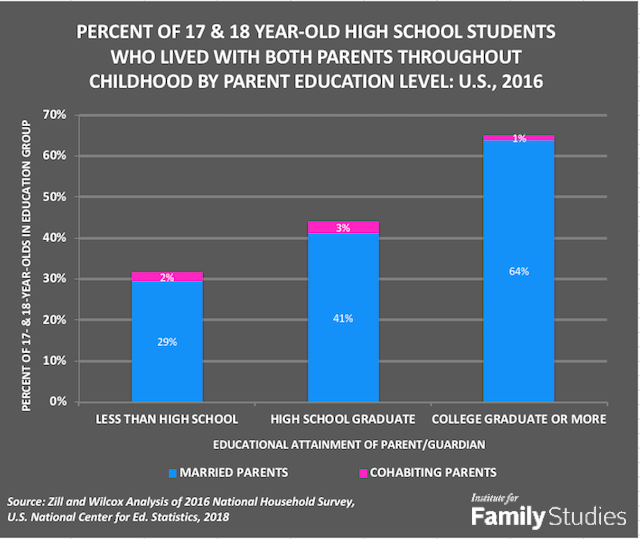Highlights
- Among students whose parents or guardians had less than a high school education, only 29% lived with married parents from birth to the end of high school. Post This
- Growing up with both parents throughout one’s childhood is more common among some racial and ethnic groups in the U.S. than among others. Post This
When it comes to today’s children, we often think about “privilege” in terms of the access to education, income, and good neighborhoods that some children benefit from and others do not. Certainly, these three forms of privilege matter for children’s welfare and for their shot at the American Dream, as Richard Reeves reminds us in Dream Hoarders.
But there is another form of “privilege” that is often overlooked in contemporary debates about children’s welfare and futures: that of growing up in a stable two-parent family—loving and being loved by one’s two parents, who are also committed to one another and to the integrity of their family. We know that children who grow up in such a stable, married family are more likely to flourish educationally, socially, and economically.
So how many of today’s young people experience this stable family structure throughout childhood?
The answer is about one-in-two, according to our new analysis of survey data files recently released by the U.S. Department of Education.1 This figure is based on the proportion of 17- and 18-year-old high school students who were reported to be living with both their married birth mothers and biological fathers in 2016.2 The fact that they were still living in such families at the culmination of their schooling means that the vast majority of them grew up in them since birth. Some may have experienced parental conflicts or temporary separations, to be sure,3 but not the kind of conflict that resulted in permanent splits. Their parents were able to work things out and the marriages endured.
As shown in Figure 1, another 15% of today’s high school seniors lived in a variety of non-traditional two-parent families in 2016: with cohabiting birth parents (2%); with one birth parent and a stepparent (11%); with a heterosexual adoptive couple (1%); or with a same-sex couple (1%). Nearly 30% of high school seniors lived in single-parent families, with either their birth mothers (23%) or biological fathers (6%).

The remaining 6% of students had experienced multiple disruptions in their family lives and resided with neither birth parent. Three percent lived with a grandmother, grandfather, or both grandparents, without their mother or father being present. One percent lived with a single step or adoptive parent. Another 2% lived with foster parents or other relatives or unrelated guardians.
More Education, More Family Stability
The more education a woman or man has, the more likely she or he is to get married and stay married when raising children. As shown in Figure 2 below, among high school seniors whose parents or guardians had a college education or more, 64% lived with married parents throughout childhood in 2016. An additional one percent lived with cohabiting birth parents.4 By contrast, among students whose parents or guardians had less than a high school education, only 29% lived with married parents from birth to the end of high school. Two percent more of these students lived with cohabiting parents. Falling between these high and low education groups were students whose parents or guardians have completed high school or have some college but no degree: 41% of these students lived with both married parents throughout childhood, and an additional 3% lived with cohabiting birth parents.

Asian-American Children Enjoy the Most Family Stability
Growing up with both parents throughout one’s childhood is more common among some racial and ethnic groups in the U.S. than among others, as shown in Figure 3. Two-thirds of Asian-American students lived with married birth parents throughout childhood, as did 58% of white students. By contrast, less than one-quarter of African-American students had experienced a stable two-parent upbringing. Hispanic-American and multiracial students had intermediate experiences: 45% of Hispanic students grew up with married birth parents, as did 35% of multiracial and other students.
Growing up with birth parents who continued to live together despite being unmarried also varies across racial and ethnic groups. It is more common among multiracial students (5%), Hispanic students (3%), and black students (3%) than among white students (1%) and Asian students (less than 1%).

The Marital Privilege
Is growing up with married birth parents advantageous for a young person’s school success and later life chances? There is abundant evidence that it is. As shown in numerous analytic studies, students with stably-married parents are more likely to do well in school and less likely to cut classes, repeat grades, be suspended or expelled, or drop out.5 And significant advantages persist after controlling for related factors like parent education level, family income and poverty status, student race and ethnicity, parent involvement, and teacher or school quality. Rich or poor, this is a type of advantage which parents from all social classes can bestow upon their children: the privilege of a growing up in a stable, married two-parent family.
Today in America, only about one-in-two children enjoy this privilege. Because the type of family in which children are raised matters a great deal to their well-being and future success, we should seek ways to enable less-educated and less-affluent parents to raise their children together in a stable family.
Nicholas Zill is a research psychologist and a senior fellow of the Institute for Family Studies. He directed the National Survey of Children, a longitudinal study that produced widely cited findings on children’s life experiences and adjustment following parental divorce.
1. The study was the 2016 National Household Education Survey, Parent and Family Involvement Component, which was a nationwide survey of parents of 14,075 school-aged children and adolescents. See https://www.nces.ed.gov/nhes
2. There were 2,828 students born in 1998 or 1999 in the NHES sample. Not all of these students were high school seniors, as some had been held back one or more grades.
3. Some may also have been born to unmarried parents who subsequently got married during the student’s childhood.
4. The parent-education level used in this tabulation was that of the more educated parent or guardian in the young person’s household.
5. For example, see: Nicholas Zill & Christine Winquist Nord (1994), Running In Place: How American Families Are Faring In A Changing Economy and An Individualistic Society. Washington, DC: Child Trends. Nicholas Zill & W. Bradford Wilcox, (2016). Strong Families, Successful Students: Family Structure and Student Performance in Ohio. Charlottesville, VA: Institute for Family Studies. Paul Amato, “The Impact of Family Formation Change on the Cognitive, Social, and Emotional Well-Being of the Next Generation,” Future of Children, 15, no. 2 (2005): 75-96; Sara McLanahan and Gary Sandefur, Growing Up With a Single Parent: What Hurts, What Helps (Cambridge, MA: Harvard, 1994); Nicholas Zill, “Family Change and Student Achievement: What We Have Learned, What It Means for Schools,” in Family-School Links: How Do They Affect Educational Outcomes?, ed. Alan Booth and Judith F. Dunn (Mahwah, NJ: Erlbaum, 1996).















